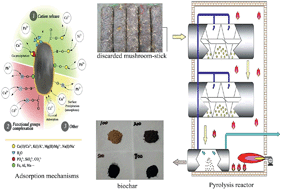Mixed heavy metal removal from wastewater by using discarded mushroom-stick biochar: adsorption properties and mechanisms†
Abstract
The physicochemical and morphological properties and the sorption capacities of discarded mushroom-stick biochar (DMB) prepared at different pyrolysis temperatures from 300 °C to 800 °C were explored. Results showed that the yield and surface oxygen-containing group content of DMB prepared at 300 °C (DMB3) were higher than those of DMB prepared at higher pyrolysis temperature (DMB5 and DMB8), while the DMB prepared at 800 °C (DMB8) had higher pH, mineral element and ash content, aromaticity, and polarity. Therefore, the heavy metal adsorption capacity of DMB3 was higher than that of DMB5, while the maximal sorption capacities for Pb2+, Cu2+, Cd2+, and Ni2+ (21.0, 18.8, 11.2, and 9.8 mg g−1) were obtained by DMB8. Adsorption kinetics and sorption isotherm data were fitted well by using pseudo-second order and Langmuir models, thereby indicating that the heavy metal adsorption by DMB was monolayer and rapid adsorption. Based on the contribution percentage parameters of diverse heavy metal sorption mechanisms, mineral precipitation and ion exchange were the two dominant mechanisms of heavy metal adsorption by DMB. This study provided a promising way not only to recycle discarded mushroom sticks into feasible heavy metal adsorbents, but also for potential utilization of agriculture waste.



 Please wait while we load your content...
Please wait while we load your content...